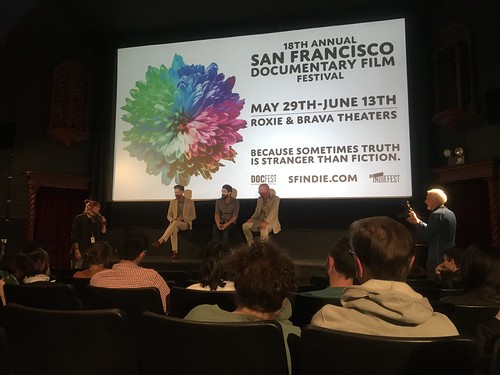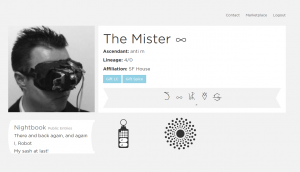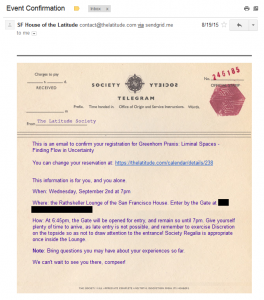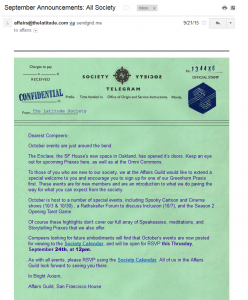I’ve been meaning to conclude my first two blog posts about Nonchalance’s The Latitude (part one, part two) with a final wrap up since 2016, and yet somehow I never quite knew what I wanted to say. Tonight, I finally have an excuse to get all my thoughts written down once and for all — because there’s now a film about The Latitude.
Earlier tonight I went to the first public screening of In Bright Axiom, a documentary(ish) film chronicling the rise and fall of The Latitude. The film is directed by Spencer McCall, who was also the director of The Institute — a similar “documentary” about Nonchalance’s previous project, The Jejune Institute.
Watch the trailer for In Bright Axiom here:
In Bright Axiom – Trailer from Spencer McCall on Vimeo.
The Film
I went to the theater not quite knowing if it would be ex-members, or just people interested in watching documentaries since it was presented as part of SF DocFest. It turned out to be a mix of both, a suspicion confirmed right away when I saw a guy sitting a few seats down from me wearing a Jejune Institute t-shirt.
Before the film started, a DocFest presenter came to the stage and introduced The Professor (Geordie Aitken) who came up to the front and warmed up the crowd with some jokes. He’s remarkably good at working crowds.
Unlike The Institute, McCall went with a more straightforward documentary style for In Bright Axiom. Even though it takes an artistic license here and there for the most part it presents (as far as I know) events as they really happened. The major exception is a pretty obvious one, which finally gives the story of The Latitude a proper ending.
I don’t want to give too many spoilers away as it’s a wonderful film, but here’s a few key insights:
- The Latitude initially held retreat(s?) in Mendocino out in the woods with a series of rituals, artists, and characters.
- Nonchalance head honcho Jeff Hull confirms a number of aspects that were widely rumored — he’s independently wealthy and (if you do some basic multiplication) was spending about a million dollars a year to run The Latitude.
- Much of the screen time goes into why The Latitude fell apart. The relationship between the creators and the participants deteriorated pretty rapidly, particularly when members were asked to pay to support it.
The question on my mind is who should see the film. Certainly anyone who took the time to read about it — whether on my blog or anywhere else — should give it a watch. The videos of The Latitude’s incredibly well designed spaces do them much more justice than static photos and descriptions ever could.
I also think creative types who are interested in immersive design should give it a watch. It’s a cautionary tale about how this type of art can become a victim of its own success when the boundaries are ill-defined. The irony of this failure when The Latitude’s internal story was all about breaking down boundaries was not lost on anyone, at least in retrospect.
The film ends with a mysterious logo appearing on the screen. What does it mean? Well, The Institute ended with the logo for The Latitude… wink, wink.

After the film there was a Q&A session with three of the people behind it, seen in the photo above. On stage from left to right there’s Geordie Aitken who played Professor Walter Kinley, director Spencer McCall, and Jeff Hull.
I had a few questions, though I never got to ask them because others beat me to the punch. I did sort of want to make an in-joke and ask Geordie if he was going to force us all to make tea, but I worried that would be too obscure. (For the record, Geordie played the poorly received Antoine Logan of the Jejune Institute in its final seminar, and he wanted us to make tea.)
One question aimed at Geordie was how he became involved in Nonchalance in the first place. He said he read about The Jejune Institute on a blog, and became so fascinated he talked Jeff into letting him take part.
Looking back, I remember after The Jejune Institute ended a bunch of us went up to Jeff, sort of ganged up on him really, and asked questions about what was next. He sheepishly mentioned he was working on an “automated house” of sorts, and that it “came to him in a dream.” In retrospect it’s obvious the “automated house” was The Latitude’s Book One, and his dream ultimately became a waking nightmare.
Though I don’t remember the question, in the Q&A it was brought up that The Jejune Institute’s designer Sara Thacher is now an Imagineer at Disney, and was most recently involved in creating the new Star Wars: Galaxy’s Edge land at both Disneyland and Disney World.
The Latitude’s Online Presence
Getting in to some other aspects of The Latitude I haven’t covered yet in previous posts, let’s talk about the user-facing interactions. Despite the somewhat anti-technology bent to the whole endeavor, the primary way to interact with The Latitude was online.
The website was kind of like a social network with a unique focus on sharing blog posts and earning badges for completing tasks. Here’s a screenshot of my profile page during the final stages of the site before it was taken down.

My username was “The Mister,” a reference to both the name “MrEricSir” and a humble riff on Doctor Who character “The Master.” The URL to my profile page was https://thelatitude.com/HEXA-AZURE-4280, with HEXA-AZURE-4280 being the “index code” on the back of my invitation card.
Emails from The Latitude always had a unique design as though they were a confidential telegram sent on special paper. Here are couple examples:


Praxes
The Latitude’s website had a calendar with many events throughout the week known as “Praxes” (plural of Praxis) which ranged from the introductory Greenhorn Praxis, members gathering for brunch, watching Saturday morning cartoons, etc.
My favorite of the praxes I attended was a workshop to build your own terrarium. Cosmic Amanda, best known as the creator of local online radio station BFF.fm, hosted the workshop. I’m proud to say one of the terrariums I built is still intact.
There never seemed to be much direct connection between The Latitude and most praxis events; it was more of a loosely connected social club where members could meet one another. Some were held in private spaces, others in public.
Closing Thoughts
If it’s not obvious enjoyed The Latitude and was sad to see it go. For my part I only joined months before the end so I was largely unaware of the internal drama that came before my time.
That said, the entire project seemed insanely ambitious. Nonchalance was renting numerous spaces in one of the most expensive cities in the world, telling a complex story, all while trying to keep a veil between themselves and the members of the (fake?) secret society they created.
The tipping point seemed to be asking for money. On one hand the membership fee wasn’t a lot for most people, on the other some members were obviously contributing a great deal of time and energy already. Perhaps there should have been a sliding scale aspect to the membership fees.
It’s also worth remembering this all took place in a part of the world where the economy is weirdly distorted: people spend $1,000 a month to live with roommates, yet eat food or take Uber rides that are heavily subsidized by venture capital — often without realizing it. Point is in the Bay Area we’ve all been conditioned to have very unrealistic ideas about cost.
On the flip side The Latitude “competed” in a way with a similar immersive experience run entirely by volunteers: Elsewhere Philatelic Society (EPS.) It wasn’t uncommon to see members of The Latitude with EPS patches sewn onto their jackets. Ironically, EPS was initially a fan-made offshoot of The Jejune Institute. With significantly lower overhead, EPS outlasted both The Jejune Institute and The Latitude, and is still around today. I think there’s a lesson here about creating these types of immersive art projects that can have a similar impact on the audience while spending far, far less money.
As what’s next for Nonchalance, they are once again working on a new project — what is it? We’ll just have to wait and see.
Until next time, in bright axiom; compeers and dark horses alike.
